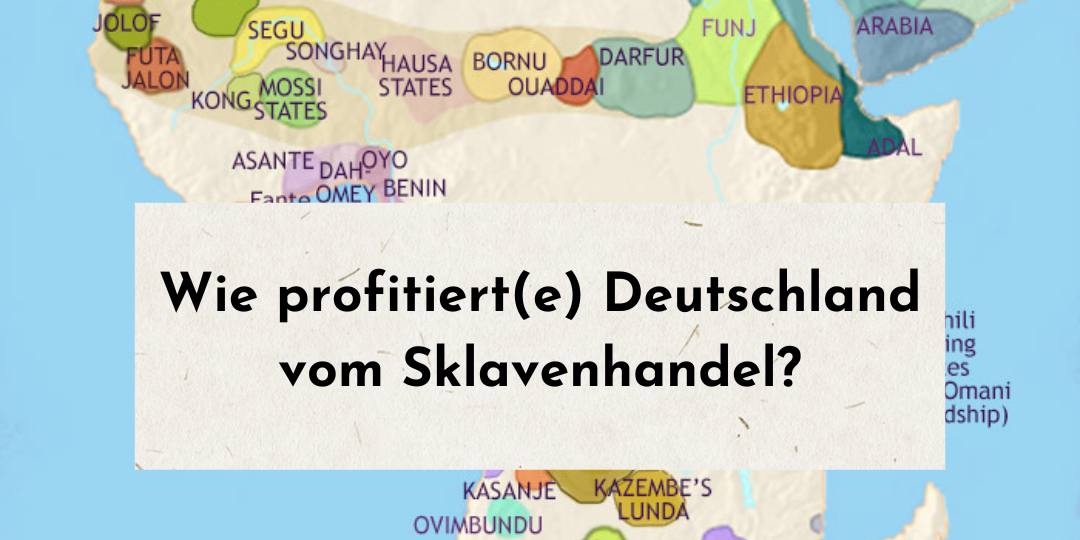The German Empire was founded in 1871 as a political entity. Before that, the area that is now called Germany consisted of various independent states. Among them were kingdoms, principalities, duchies and free cities. These states had different political systems, forms of government, and economic structures.
Thus, starting in 1680, under Elector Friedrich Wilhelm, a small colony was established on the coast of Ghana, where the “Fortress Groß-Friedrichsburg” was also built, which served as a transshipment point and is still partly preserved today.
The Elector himself ordered animals and “half a dozen” teenage Ghanaians from “his” colony, based on the racist ideologies that were already widespread at the time. Besides people, he also bought gold and ivory. He was the first German trafficker to arrange for the abduction of some 30,000 West Africans to the Caribbean, almost half of whom did not survive the crossing.
Heinrich Carl v. Schimmelmann imported goods of various kinds: from textiles to weapons from what is now Germany to African territories and traded them for people, whom he then abducted onto ships bound for the Caribbean. He also owned a handful of his own large cotton and sugar cane plantations on several islands, making him a millionaire.
Peter Meyer was also a criminal merchant who profited so much from human trafficking that he became a director of the Royal African Company, acquired a plantation in Barbados and also lined his pockets with other investments.
In addition, the Sauerland Friedrich Romberg founded at the end of the 18th century. even one of the world’s largest human trafficking agencies – with over 100 ships and 20 plantations in Haiti – he also became a multimillionaire as a result.
All these companies have had a positive economic impact on the German states.
Moreover, the Germans invested in the imperialist actions of other countries from the very beginning. Among them are Portugal, Denmark or Spain. The Germans often produced goods or ships that were then sold or traded.
Examples are the cauldrons in which sugar cane juice was produced on the Caribbean plantations or the iron for chains and shackles? or the linen fabrics for ship sails of various fleets?
“That was just two or three bad men…?”
Hm, and what about all the jobs created and maintained by German slavery? Whether in administration, ship personnel, logistics, military, missions, teachers, lawyers, farmers, medical. Personnel, painters, craftsmen, middlemen, scientists… just two or three individuals, then?
By the way – some German abducted people even after the abolition of slavery continued for a while, just secretly and illegally.
Okay, but what does that have to do with us today?
Not for nothing was e.g. a new bust of Schimmelmann was erected in Hamburg in 2006: The activities of the Germans in the global trade with enslaved people enriched the German financial and capital system which, among other things, flowed into the raw materials and metal industry, which is one of the foundations of our current prosperity. Due to the financial boom, the German population also grew in the 17th century. strongly on. At the same time, the growth of German industry in turn enriched slavery:
Some companies financed by slave money at that time still exist today: who of you is with Commerzbank? It was created by Theodor Wille, a coffee merchant who exploited enslaved people for his work. One of the founders was Carl Woermann, who himself worked with various companies. Goods was actively involved in triangular trade. his descendants, especially Adolph Woermann, continued the business by displaced & forced to work. After the loss of the colonies at the time of colonialism & the world wars, the company opened branches in Angola, Ghana and Namibia, where there are still supermarkets under the name today.



… [Trackback]
[…] There you will find 89144 more Infos: decolonialtours.com/2023/07/how-germany-profited-from-the-slave-trade/ […]
Hello, I have read through this article and learned a lot about the merchants you have mentioned, thank you.
It has been established that some German states exported linen, brass and iron ingots to other European powers who then traded such commodities for slaves in order to export sugar.
When you mention the jobs maintained by German slavery, how do you estimate this? German states are assumed to be already major economic powers prior to the transatlantic trade with cities like Cologne, Lübeck and Heidelberg. How much would you estimate GDP growth due to slavery alone during the time it existed, considering Germany had many other export partners like Poland, Russia and the Ottomans?
Would you apportion blame to the industries of linen, metal and glass that slavers bought from for further export ? It seems difficult to blame a textile exporter for their products being used for criminal activities, couldn’t one blame countries like Morocco, Russia and China for trading with companies involved with transatlantic slavery equally? I understand this article is about German involvement, I am interested in whether you place the blame with those who were directly involved or indirectly involved.
Considering that major slave trading families and nations such as France and the Spanish Habsburgs funded wars against Germany which devastated lands such as the Rhineland where this industry once laid, how would you estimate the positive effects this trade had on the modern German economy? Did Napoleon’s destruction of the Rhineland cancel that out ? What figure sum would you put it at?